Take a Load Off with Phase Change Materials
/In a world where energy prices are rising, power grids are being overtaxed, and evolving building codes are pushing for electrification, a greater need for shifting electricity loads is emerging. Thermal Energy Storage (TES) can help by allowing energy to be stored during off peak hours for later use when it is needed most. Shifting energy loads off peak is a strategy that is being implemented by more utilities. It reduces strain on already burdened power grids and allows for energy demands to be met and paired with greener methods when they are available.
Phase change materials (PCM) are quickly being recognized as a great way to utilize this strategy of storing thermal energy and releasing it on demand. A phase change material has a phase transition temperature that can utilize the absorption and release of energy in practical applications. For buildings, this is usually in the range of temperatures that are comfortable for humans. These materials can be incorporated in different applications within buildings, be it space heating or domestic hot water heating, and are becoming more and more available for use by builders and manufacturers.
Read More










